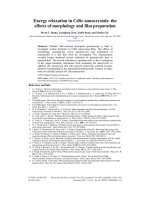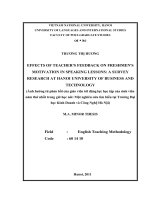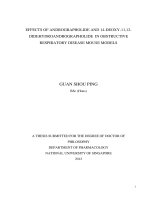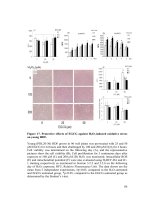Effects of microbial products and urea in biodegradable rice straw on the growth and yield of rice in acid sulfate soils, Đong Thap province
Bạn đang xem bản rút gọn của tài liệu. Xem và tải ngay bản đầy đủ của tài liệu tại đây (260.29 KB, 8 trang )
AGU International Journal of Sciences – 2019, Vol 7 (3), 91 – 98
EFFECTS OF MICROBIAL PRODUCTS AND UREA IN BIODEGRADABLE RICE
STRAW ON THE GROWTH AND YIELD OF RICE IN ACID SULFATE SOILS, DONG
THAP PROVINCE
Mai Vu Duy1, Nguyen Bao Ve1, Nguyen Thanh Hoi1, Nguyen Thanh Tai2
1
Can Tho University
Dong Thap Department of Science and Technology
2
Information:
Received: 08/03/2019
Accepted: 11/06/2019
Published: 11/2019
Keywords:
Urea, Trichomix-DT,
TricôĐHCT-Lua von, Dascela,
yield of rice, acid sulfate soil.
ABSTRACT
The field experiment was conducted to study microbial product and urea
effects in decomposing rice straw on the growth and yield of rice grown in
acid sulfate soils in a three rice cropping system, at Tam Nong district,
Dong Thap province, in the Autumn-Winter crop of 2016. The experiment
was carried out in factorial design with 2 factors in randomized complete
blocks with 3 replications. The first factor - treatment of Urea- included: (1)
untreated (2) treated with Urea. The second factor - type of microbial
products- included (1) untreated, (2) treated with Trichomix-DT, (3) treated
with TricôĐHCT-Lua von (4) treated with Dascela. The results showed that
incorporporation of rice straw treated with Dascela increased the number
of full grains per panicle (78 fully grains per panicle), the number of
panicles per m2 (447,7 panicle /m2) and grain yield (5,95 t/ha). The
combination of rice straw treated with Dascela and Urea increased density
of Cellulomonas flavigena bacteria and the number of tillers per m 2. Urea
treatment increased density of Cellulomonas flavigena bacteria.
1. INTRODUCTION
implement it. Therefore, to reduce the labor of
farmers in the straw incubation, the hypothesis
is to spread straw on the field then use the
bacterial decomposition of straw to accelerate
straw
decomposition
under
submerged
conditions. In Vietnam, the study by Van Phuoc
Vo and Cao Ngoc Diep (2011) isolated and
multiplied the success Q4 strains from bovine
rumen fluid which were capable of producing
cellulose enzyme, cell analysis molecular-based
16S rRNA sequences that strains Q4
isomorphic with the Cellulomonas flavigena,
and recomposed effectively photocopy paper
Organic poisoning usually occurs on intensive
farming land, due to the fact that organic
material such as straw, and floral decompose in
wetlands, creating toxins such as organic acids,
and H2S (Ponnamperuma, 1984; Gao et al.,
2004; Kyuma, 2004). In orderfor decomposition
of straw to occur quickly, Luu Hong Man et al.
(2005) fertilized straw by incubating it with
Trichoderma sp. and saw a significant yield
increase compared to unfertilized control.
However, the straw compost can take a lot of
effort, and it is difficult to encourage farmers to
91
AGU International Journal of Sciences – 2019, Vol 7 (3), 91 – 98
108
CFU/g, Streptomyces spp. > 106
CFU/g),
Phosphorus
microorganisms
9
(Bacillus
subtilis>
10
CFU/g
;
6
Pseudomonas
sp. >
10
CFU/g),
macronutrients, intermediate and organic
matter.
- TricôĐHCT-Lúavon: 108 spore/g; The
product contains 80% w / w Trichoderma
asperellum and 20% Trichoderma atroviride
Karsten.
- Dascela:
the
product
contains
macronutrients, intermediate and organic
matter. cellulolytic Cellulomonas flavigena
bacteria 108 CFU / g.
and straw. According to Sami et al. (1988)
Cellulomonas flavigena bacteria are capable of
decomposing straw in 7 days by cellulase and
hemicellulase secretion. Vo Hung Nhiem
(2012), using microbial products containing
cellulolytic Cellulomonas flavigena bacteria
showed that this helped to decompose rice
straw in 7-10 days after treatment.
Currently, high-yielding rice varieties like short
OM4900 are promising, showing good
tolerance to some insects, diseases and it is
growing in popularity in the Mekong Delta
provinces. However, studies using the strain
Cellulomonas flavigena, Azospirillum sp.,
Peudomonas sp on the rice IR50404, to reduce
the toxicity of organic, reduce chemical
fertilizer, increasing yields on land rice straw
fresh buried in flooded conditions, are still
limited. Therefore, the field experiment was
conducted to study some microbial product and
urea effects in decomposing rice straw on the
growth and yield of rice grown in acid sulfate
soils in three rice cropping system.
2.2 Methods
2.2.1. Experimental arrangement
The experiment was carried out in factorial
design with 2 factors in randomized complete
block with 3 replications (each replication was
on a plot with an area of 25 m2 per plot). The
first factor, treatment of Urea, included: (1)
untreated (2) treated with Urea. The second
factor, type of microbial products, included (1)
untreated, (2) treated with Trichomix-DT, (3)
treated with TricôĐHCT-Lua von and (4)
treated with Dascela.
2. MATERIALS AND METHODS
2.1 Materials
* The experiment was conducted in the Autumn
and Winter (2016) in Tam Nong district, Dong
Thap province.
Rice straw after harvest was cut and a weight of
rice straw used for the treatments was 6 tons /
ha (15 kg / 25 m2, calculated assuming a
moisture content of 14%) and spread evenly
over each plot. Then, rice straw was
incorporated in the soil by hand. Microbial
products were used as follows: (1) TrichomixDT was dissolved in water at a rate of 0.3 kg /
1000 m2 and sprayed evenly on straw; (2)
TrichĐĐCTCT-Von was dissolved in water at
a rate of 200 g / 1,000 m2 and sprayed evenly
on rice straw; (3) Dascela was spread directly
on the field at a rate of 30 kg / ha covered with
rice straw. Urea fertilizer was used in the
treatment with a weight of 2.5 kg / 1.000 m2,
* Acid sulfate soils are a group of soils that are
difficult to use and difficult to improve, limited
by acid sulfate toxins, high acidity, rich in N
and K but very poor P.
* OM4900 has a growth period shorter than 95100 days from direct seeding. This variety has a
high tolerance to salinity and acid sulfate soils,
is widely adapted, and has yields in SummerAutumn and Autumn-Winter seasons of 5-5,5
tons / ha, and in Winter-spring 6,5-7,0 tons / ha
* Microbial products:
- Trichomix-DT:
products
contains
cellulolytic bacteria (Trichoderma spp. >
92
AGU International Journal of Sciences – 2019, Vol 7 (3), 91 – 98
mixed with water and sprayed onto each
experimental plot after incorpoarting of rice
straws. After 10 days of implementation, the
rice was sown.
2.2.3. Statistical analysis:
The data were analyzed using SPSS 16.0
software (SPSS, Inc., Chicago, IL, USA).
Significant differences among the means were
determined by Duncan’s Multiple Range test at
a 95% probability.
The rice seed density and fertilizer (according
to local farmers) were as follows: Hand-seeded
rice seeded by hand with a density of 120 kg /
ha. The fertilizer was divided into 3 stages with
a fertilizer formula: 100 N- 80 P2O5- 50 K2O.
3. RESULTS AND DISCUSSION
3.1 Density
bacteria
+ Promotion fertilizing 1: 25% N- 28% P2O524% K2O, 7 days after sowing.
of
Cellulomonas
flavigena
Table 1 shows that, in 0-10cm of topsoil, rice
straw treated with Dascela obtained the highest
density of Cellulomonas flavigena bacteria. The
combination of rice straw treated with Dascela
and Urea obtained the highest density of
Cellulomonas flavigena bacteria. In 10-20 cm
of the topsoil,, density of Cellulomonas
flavigena bacteria of urea treatment was higher
than that of untreated. Rice straw treated with
Dascela obtained the highest density of
Cellulomonas flavigena bacteria, significantly
different from the remaining type of microbial
products (excepting rice straw treated with
Trichomix-DT).
+ Promotion fertilizing 2: 35% N- 42% P2O528% K2O, 16 days after sowing.
+ Earing dressing: 40% N- 30% P2O5- 48%
K2O, 33 days after sowing.
2.2.2. Details of data collection
+ Rice sampling: Collected data were plant
height (cm), number of tillers, number of
panicles per m2, number full grains per panicle,
filled grain ratio (%), 1.000 - grain weight (g),
and grain yield (IRRI, 1995). The N, Ndimethyl formamide method was used to
analyze chlorophyll value (Moran, 1982).
+ Soil sampling: density of Cellulomonas
flavigena bacteria (Ulrich et al., 2008).
Table 1. Density of Cellulomonas flavigena bacteria (x 105 cfu/g)
Urea (A)
Untreated
Type of microbial
products (B)
In the topsoil 0-10 cm
In the topsoil 10-20 cm
11,0 c
13,5 c
11,0 d
19,0 b
20,0
24,0
25,0
27,0
13,6
24,0 b
10,5 d
12,0 cd
11,5 d
23,0 a
14,3
25,0
29,0
24,0
28,0
26,5a
Untreated
Trichomix-DT
TricôĐHCT- lua von
Dascela
A
Treated with
Urea
Untreated
Trichomix-DT
TricôĐHCT- lua von
Dascela
A
93
AGU International Journal of Sciences – 2019, Vol 7 (3), 91 – 98
Untreated
Trichomix-DT
TricôĐHCT- lua von
Dascela
B
10,8 b
12,8 a
11,3 a
21,0 a
ns
**
**
7,53
F (A)
F (B)
F (AxB)
CV (%)
22,5 c
26,5 ab
24,5 bc
27,5 a
*
**
ns
8,96
Note: Values within each column with the same letters are significantly different by Duncan’s test, ns: no
significantly different; *: significantly different at 5%, **: significantly different at 1%.
3.2 Plant height
Table 2 shows that treatment of Urea and type
of microbial products did not affect the plant
height. There was no interaction between urea
and type of microbial products with plant
height. Plant height in the treatments changed
from 33,5-34,9; 54,5-59,6; 89,65-91,08; 95,999,1 cm at 20, 40, 60 days after sowing and
harvest.
Table 2. The plant height (cm) at 20, 40, 60 days after sowing and harvest.
Urea (A)
Untreated
Treated
with Urea
B
Days after sowing
Type of microbial
products (B)
Untreated
Trichomix-DT
TricôĐHCT- lua von
Dascela
A
Untreated
Trichomix-DT
TricôĐHCT- lua von
Dascela
A
Untreated
Trichomix-DT
TricôĐHCT- lua von
Dascela
F (A)
F (B)
F (AxB)
CV (%)
20
33,5
34,9
34,5
35,4
34,6
34,0
34,8
34,6
34,0
34,3
33,7
34,8
34,6
34,7
ns
ns
ns
14,4
40
56,1
57,8
56,4
59,6
57,5
56,7
57,5
57,4
54,5
56,5
56,4
57,7
56,9
57,0
ns
ns
ns
11,4
Note: ns: no significantly different
94
60
90,31
89,65
90,09
91,08
90,31
90,09
90,64
90,31
90,31
90,31
90,2
90,2
90,2
90,75
ns
ns
ns
12,2
Harvest
hoa
96,6
hoạch
95,9
99,1
96,4
97,0
96,6
98,2
97,1
97,2
97,3
96,6
97,0
98,2
96,8
ns
ns
ns
8,6
AGU International Journal of Sciences – 2019, Vol 7 (3), 91 – 98
3.3
The number tillers/m2
microbial products to the number tillers/m2. The
combination of rice straw untreated with
microbial products and Urea obtained the
lowest the number of tillers/m2, and was
significantly different from the remaining
treatments.
Table 2 shows that microbial products did not
affect the number tillers/m2 at 20, 40 days after
sowing. However, type of microbial products
were significantly different at the 5% level for
the number tillers/m2 at 60 days after sowing.
There is an interaction between urea and type of
Table 3. The number tillers/m2 at 20, 40, 60 days after sowing
Urea (A)
Untreated
Treated
with Urea
B
Type of microbial
20
products (B)
Untreated
Trichomix-DT
TricôĐHCT- lua von
Dascela
A
Untreated
Trichomix-DT
TricôĐHCT- lua von
Dascela
A
Untreated
Trichomix-DT
TricôĐHCT- lua von
Dascela
F (A)
F (B)
F (AxB)
CV (%)
495,6
500,0
491,2
490,8
494,4
485,2
532,8
483,2
548,0
512,3
490,4
516,4
487,2
519,4
ns
ns
ns
5,35
Days after sowing
40
565,2
563,2
592,8
575,6
574,2
560,8
612,0
566,8
650,8
597,6
563,0
587,6
579,8
613,2
ns
ns
ns
5,52
60
400,4b
485,8a
499,8a
478,1a
466,03
461,3a
460,6a
482,9a
464,1a
467,23
430,9b
473,2a
491,4a
471,1a
ns
**
*
5,43
Note: ns: no significantly different
3.4 Chlorophyll value
Table 4 shows that urea treatment did not affect the chlorophyll value a, b, ab value at 60 days after
sowing. The chlorophyll value a, b, ab in the treatments changed from 1,266-1,750; 0,818-1,406;
2,157-3,007 (µg/mg) at 60 days after sowing.
Table 4. Chlorophyll value (µg/mg) at 60 days after sowing
Urea (A)
Type of microbial
products (B)
Untreated
Untreated
60 days after sowing
Chlorophyll a
Chlorophyll b
1,6
0,913
95
Chlorophyll ab
2,516
AGU International Journal of Sciences – 2019, Vol 7 (3), 91 – 98
Treated
with Urea
B
Trichomix-DT
1,4
0,818
2,157
TricôĐHCT- lua von
1,4
0,978
2,385
Dascela
A
Untreated
Trichomix-DT
TricôĐHCT- lua von
Dascela
A
Untreated
Trichomix-DT
TricôĐHCT- lua von
Dascela
1,6
1,5
1,3
1,3
1,5
1,8
1,449
1,453
1,302
1,442
1,675
ns
ns
ns
20,3
1,406
1,029
1,099
0,884
1,135
0,901
1,005
1,006
0,851
1,056
1,154
ns
ns
ns
24,1
3,007
2,516
2,403
2,151
2,611
2,652
2,454
2,460
2,154
2,498
2,829
ns
ns
ns
18,9
F (A)
F (B)
F (AxB)
CV (%)
Note: ns: no significantly different
3.5 The components of yield and and grain
yield
number of filled grains per panicle (78,0 filled
grains per panicle), significantly different from
the remaining type of microbial products. There
was no interaction between urea and type of
microbial products to the number of filled
grains per panicle. Number of filled grains per
panicle in the treatments changed from 70,980,0 filled grains per panicle.
3.5.1 Number of panicles/m2
Table 5 shows that urea treatment did not affect
number of panicles/m2. Rice straw treated with
Dascela and Trichomix-DT obtained the highest
number of panicles/m2 (379,7-447,7 number of
panicles/m2), significantly different from the
remaining types of microbial products.
3.5.3 Filled grain ratio
Table 5 shows that urea treatment and microbial
products did not affect the number of filled
grains per panicle. Filled grain ratio in the
treatments changed from 71,59-77,22%.
3.5.2 Number of filled grains per panicle
Table 5 shows that urea treatment did not affect
the number of filled grains per panicle. Rice
straw treated with Dascela obtained the highest
Table 5. The components of yield
Urea (A)
Type of
microbial
products (B)
Untreated
Untreated
Trichomix-DT
TricôĐHCT- lua
von
Dascela
Number of
panicles/m2
Number of
filled grains
per panicle
386,0
418,4
386,7
448,7
72,0
72,0
72,1
75,9
96
Filled grain
ratio (%)
77,22
74,48
74,33
74,47
1000-grain
weight (g)
26,5
26,7
26,8
26,9
AGU International Journal of Sciences – 2019, Vol 7 (3), 91 – 98
Treated
with Urea
B
A
Untreated
Trichomix-DT
TricôĐHCT- lua
von
Dascela
A
Untreated
Trichomix-DT
TricôĐHCT- lua
von
Dascela
F (A)
F (B)
F (AxB)
CV (%)
409,9
374,0
449,3
372,7
446,7
410,7
380,0 b
433,9 a
379,7 b
447,7 a
ns
**
ns
5,3
73,0
73,9
70,9
71,4
80,0
74,1
72,9 b
71,4 b
71,7 b
78,0 a
ns
ns
ns
6,36
75,13
76,58
75,82
74,01
71,59
74,50
76,90
75,15
74,17
73,03
ns
ns
ns
6,1
26,7
26,9
26,6
26,7
26,5
26,7
26,70
26,65
26,75
26,70
ns
ns
ns
5,95
Note: Values within each column with the same letters are significantly different by Duncan’s test, ns: no
significantly different, **: significantly different at 1%.
3.5.4 1000-grain weight
Table 5 shows that the urea treatment did not
affect grain yield. Rice straw treated with
Dascela and Trichomix-DT obtained the highest
grain yield (379,7-447,7 tons/ha), significantly
different from the remaining type of microbial
products. and seed setting rates. According to
Duy et al. (2015), rice straw treated with
microbial products containing Cellulomonas
flavigena bacteria increased the number of
tillers/m2, number of panicles/m2, grain yield,
and reduced inorganic fertilizer by 25% (25 kg
N and 15 kg P2O5).
Urea treatment and microbial products did not
affect 1000-grain weight. 1000-grain weight in
the treatments changed from 26,5-26,9 g (Table
5). According to Yoshida (1981), grain weight
is a feature of the variety and the grain size is
controlled tightly by rice husk. So, the grain can
not grow more than the size of husk, even under
advantageous conditions and when water and
nutrition are provided sufficiently.
3.5.5 Grain yield
Table 6. Grain yield (tons/ha)
Type of microbial products (B)
Urea (A)
Untreated
Treated with
Urea
(B)
F (A)
F (B)
Untreated
5,13
5,33
5,23 b
(A)
Trichomix-DT
5,53
TricôĐHCTlúa
5,33
Dascela
6,00
5,50
6,13
5,20
5,90
5,64
5,83 a
5,27b b
bbb b
5,95a
aaaa aaa a
ns
**
F (A)*(B)
CV (%)
ns
5,61
Note: Values within each column with the same letters are significantly different by Duncan’s test, ns: no
significantly different, **: significantly different at 1%.
97
AGU International Journal of Sciences – 2019, Vol 7 (3), 91 – 98
4. CONCLUSION
drainage and soybean tillage treatments on
rainfed, soybean grown after wetland rice.
IRRI Annual Report for 1979, Loss Bons,
Philippines.
The incorpoartion of rice straws treated with
Dascela increased the number of full grains per
panicle (78 fully grains per panicle), the
number of panicles per m2 (447,7 panicle /m2)
Sami, A.J., M.W. Akhtar., N.N. Malik., & B.A.
Naz. (1988). Production of free and
substrate bound cellulases of Cellulomonas
flavigena. Enzyme Microb, 10, 626-631.
and grain yield (5,95 t/ha).
Urea
treatment
increased
density
Cellulomonas flavigena bacteria.
of
Ulrich A., G. Klimke., &S. Wirth. (2008).
Diversity and activity of cellulose
decomposing bacteria, Isolated from a
Sandy and a Loamy Soil after Long-Term
Manure Application. Microb Ecol, 55, 512–
522.
The combination of rice straw treated with
Dascela and Urea increased density of
Cellulomonas flavigena bacteria and the
number of tillers per m2 (20 day after sowing).
REFERENCES
Vo Hung Nhiem. (2012). Dascela – Dasvila, a
new and innovative combination of
biotechnology in the Mekong Delta. 6th
agriculture extension forum. Agricultural
Publishing House Ho Chi Minh.
Gao, S., K.K. Tanji & S.C. Scardaci. (2004).
Impact of rice straw incorporation on soil
redox status and sulfide toxicity. Agronomy.
J, 96, 70 – 76.
Kyuma, K. (2004). Paddy soil science. Kyoto:
Kyoto University Press andMelbourne:
Trans Pacific Press.
Vo Van Phuoc Que and Cao Ngoc Diep, 2011.
Isolation
and
Identification
of
cellulolytic bacteria. Journal of Science of
Cantho university. 18a, tr. 177-184.
Luu Hong Man., Vu Tien Khang., &Watanabe
T. (2005). Improvement of soil fertility by
rice straw manure. Omonrice Journal 13.
CLRRI, 52-62.
Yoshida, S. (1981). Fundamentals of rice crop
science. IRRI. Los Banos. Laguna.
Philippines.
Moran, R. & D. Porath. (1982). Chlorophyll
determination in intact tissues using N,NDimethylformamide. Plant Physiol, 65, 478479.
Duy, M.V., Hoi, N.T., Ve, N.B., Thuc, L.V.,
Trang, N.Q. (2015). Influence of
Cellulomonas flavigena, Azospirillum sp.
and Pseudomonas sp. on rice growth and
yield grown in submerged soil amended
with rice straw.Recent trends PGPR
research for sustainable crop productivity 4
th Asian PGPR conference Proceeding, Ha
Noi, VietNam.
Ponnamperuma. (1984). Straw as soruce of
nutrient for wetland rice, organic matter and
rice. International Rice Research Instiue.
Roots of two varieties of rice (Oryza sativa
L.), Biol. Fertil. Soils, 4, 3-7.
IRRI
(International
Rice
Institute).(1995). Effect of
Research
rice land
98









